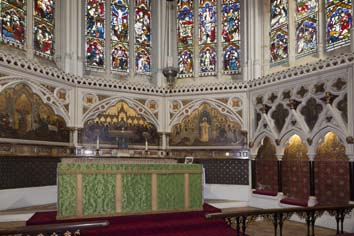Hastings – Holy Trinity, Robertson Street
Development of the area between Castle Hill and St Leonards accelerated after a railway station was planned and by 1851 there were plans for a church on a slope on the fringe of the area. Following a landslip there, a more level and central site in Robertson Street was bought for £2500 and the nave and north aisle were started in 1856 (M Saunders p27) and opened two years later. Building continued until 1859, which was probably when the chancel was completed. The cost was said to be £8000 (KD 1899).
The first vicar, T F Crosse, was curate at Battle when S S Teulon built Netherfield church in that parish, which may explain why he was chosen here (Saunders, ibid). Teulon produced an ingenious and ornate church on an awkward triangular site. The east end is most immediately visible, placed at the apex of the triangle. Its big windows, each in a gable which is now truncated, create a jagged effect which is repeated in the north aisle, where each window is similarly treated. Nicholas Antram gives the source for this motif as St Pierre, Caen, Normandy (BE(E) p428). This feature determines the form of the roof inside and each window is separated by a buttress to create a sequence of recesses; the effect is repeated in the south aisle. The south side is at an angle to the rest and should largely have been taken up by a tower, of which only a stump serving as a porch was built. Quartermain’s ((E) p110) drawing shows it would have had big traceried bell-openings, carved battlements and an octagonal stair-turret with a pointed and crocketed top.
Teulon’s tracery is notionally in the style of c1300, but its spiky carving, oddities of form and proportions are characteristic of his work – the window in the west gable of the south aisle defies analysis. The doorway beneath is also odd, for though it has a conventional inner opening, it is set in a taller arch. The space above (hardly a tympanum since the lower arch breaks into it) contains tracery, centred on a more heavily delineated spherical triangle. The spacious but dark interior has six-bay arcades. Brackets on the nave side of the capitals support shafts for the wallposts of the roof. The profusely carved corbels of the chancel roof are almost certainly by T Earp, who also did the carving beneath the organ (Mitchell p44).
In the later C19 the previously evangelical parish moved in the direction of Anglo-Catholicism, and the church was remodelled and refitted in 1890-92 by W H Romayne-Walker (M Saunders p28). The most conspicuous external change was the prominent vestry at the east end, in the apex of the triangle. Its detail is Perp, with a conical roof. Inside, Earp returned to enrich the chancel arch with carved angels (Faber Guide p52) and probably also decorated the doors and windows of the chancel. Most fittings (see below) date from this time. Because of the exposed site, the stonework decayed quickly and in 1906 H Ward renovated the west roundel and doorway (BN 91 p386), following Teulon’s design faithfully. In the following year Ward adapted the east end of the south aisle as a Lady Chapel, which is in effect a complete chapel in miniature (BE(E) p429).
Parishes in town centres have not fared well as depopulation has taken its toll and Holy Trinity was no exception. In 2014 a team from St Peter, Brighton took over the running of the church as part of the Holy Trinity, Brompton network, though the parish still has a vicar. It is seeking to revivify the church with a greater appeal to younger people. At St Peter’s this has led to extensive changes inside but so far such changes have been less in evidence here and more traditional services are still held.
Fittings
Font: Round and dating from the 1850s, with exuberantly carved leaves added in 1903 (M Saunders p28).
Font-cover: Tall and traceried, probably of 1890 or 1903 and by the same hand as the screen (see below).
Glass:
1. (Five apse windows) Clayton and Bell, 1862-67 (ESRO Par 365/4/2/4).
2. (West window) Clayton and Bell, 1881 (BN 40 p8). The saints depicted are the patrons of the Hastings churches that existed at the time (1 p2).
3. (North aisle, middle window) Clayton and Bell, c1871 (1 p5) (Ellen and Anna Wynne).
4. (North aisle,first and second windows) C E Kempe, 1888-91.
5. (North chancel, rose) Clayton and Bell, 1871 (ESRO Par 365/4/2/4).
Memorial: (Lady chapel) Brass to Susan Harcourt (d1894 but erected 1921) designed by Sir R Paget (BE(E) ibid).
Pulpit: Massive alabaster by Romayne-Walker, 1898, with a Jacobean-style tester, reached by two flights of steps.
Reredos: Remarkable for its paintings in imitation of C13 Italian work, including the Last Supper. The Victorians usually preferred later schools, especially if the date of 1873 (BE(E) ibid) is correct. The paintings are set in the sides of the apse.
Screen: 1890 (WSRO Ep/II/27/137), ornate and probably by Romayne-Walker. It is said to have been carved in Ghent, Belgium (BE(E) ibid).
Triptych: Embroidered triptych, M Cantrell in oak frame.
War memorial: (West end) in the form of a gothic screen and attributed to P W Cole, with the probable assistance of his students from the Hastings School of Art (BE(E) ibid).
Source
1. Anon (‘CT’): Windows, Holy Trinity, 1997
My thanks to Nick Wiseman for drawing my attention to source 1 above – this is a model of its kind with a wealth of information about the subject-matter of the windows. I am also grateful to him for the photographs.









